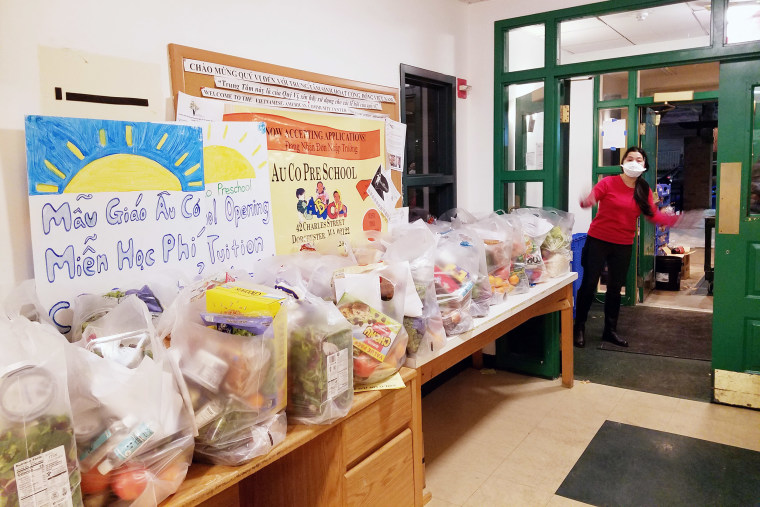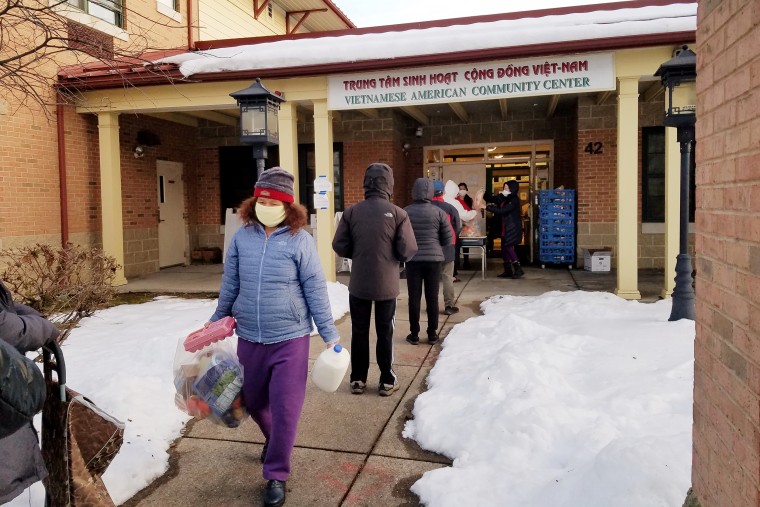On a recent winter afternoon, a long line of people, bundled in coats and hats against the cold, waited outside VietAid, a nonprofit that serves Boston’s Vietnamese community.
VietAid, based in the neighborhood of Dorchester, started distributing food for the first time last March to help Vietnamese people and others struggling during the pandemic. More than 300 people now receive free groceries each week from VietAid and its partner Fair Foods.
Jasmine Deo, 77, of Dorchester, hefted her bag bulging with potatoes, oranges, tomatoes, cauliflower and a can of soup. A loaf of bread and a box of cornflakes poked out from the top.
Her adult children used to work at a nail salon, which has since closed amid the pandemic. “Nobody [is] working now,” Deo told NBC Asian America.
Across the U.S., vulnerable people of Asian descent — many of whom are low-income, recent immigrants, undocumented and elderly — are facing food insecurity as they cope with record unemployment.
“The scale of job losses was unprecedented as many are disproportionately represented in low-paying service jobs,” said Thoai Nguyen, CEO of the Southeast Asian Mutual Assistance Associations Coalition (Seamaac) a social services organization in Philadelphia.
Hunger and food insecurity are perennial but often invisible problems among low-income Asian Americans. The Covid-19 pandemic — which has heavily affected many of the industries that employ low-income Asian Americans, including restaurants, salons and small factories — has exacerbated their economic hardship and highlighted the challenges in helping them. In response, community organizations from Philadelphia to San Francisco are now trying to meet urgent demand for food by distributing free meals and groceries.
Seamaac, for instance, distributes about 7,000 free meals and groceries each week. Half of the recipients are of Asian descent. This month Seamaac, through funding from the federal government, foundations and individuals, will distribute more than 500,000 meals, boxes of groceries, food pantry items and other food aid.
“Asian poverty statistics make people gasp. There’s a myth about wealthy Asian Americans that really stymies our community."
In the San Francisco area, Self-Help for the Elderly delivered almost 5,000 meals each day during the height of the pandemic last spring. The nonprofit, which works mostly with Asian seniors, still serves around 2,400 meals every day.
Food insecurity has long been a problem in Asian American communities, “but it was almost impossible to convince any of the mainstream hunger relief organizations that this was real and urgent,” said Nguyen.
Contrary to the common misperception of Asian American wealth and success, poverty among Asian Americans in the U.S. is high. In New York City, for instance, 1 in 4 Asians live in poverty and half have limited English, according to the nonprofit Asian American Federation (AAF). In Boston, meanwhile, poverty among Asians was nearly 26.6 percent compared to 23 percent among the city’s Black population, according to a 2014 report from the Boston Redevelopment Authority.
“Asian poverty statistics make people gasp. There’s a myth about wealthy Asian Americans that really stymies our community,” said Jo-Ann Yoo, executive director of AAF in New York.
In New York City, unemployment among Asians soared to 25 percent last year — the largest increase among all racial groups, according to an AAF report published last fall. In California, 83 percent of Asian Americans with high school degrees or less filed unemployment claims, compared to 37 percent for non-Asians, according to a report from UCLA researchers last July.
Six of AAF’s nonprofit partners increased their existing senior food programs, so that last year they distributed food more than 19,000 times to 2,800 Asian senior citizens.
Lisette Le, executive director of VietAid, also pointed out that children who qualified for free school lunch also have fewer options to eat while schools remain closed.
In addition to distributing groceries, VietAid, whose food program is funded by the city of Boston and other sources, serves take-out meals to more than 125 families each day with its partner Boston YWCA. At the start of the pandemic, VietAid was delivering food to as many as 125 senior citizens each week.

VietAid also partnered with the Boston nonprofit Chinese Progressive Association and other groups last year to hire 78 community members to prepare and distribute meals.
Even Asian community organizations that previously didn’t work on hunger relief have now pivoted to food aid because of urgent demand. Chinese for Affirmative Action (CAA), a San Francisco nonprofit that normally works on policy issues, such as immigration and education, now offers food aid. During the pandemic the group has provided food assistance for about 750 people.
“Food, housing and work are top concerns,” said Annette Wong, CAA programs director. She recalled a Chinese man who called CAA in tears, frustrated after waiting hours in line at a food pantry.
The Cantonese speaker “was at his wits’ ends. Some people are in desperate and dire situations,” said Wong.
But it's unclear how long the program will last. Funding for CAA’s food aid, which comes from the city’s Give2SF online donation program, will soon end.
One important benefit of local community organizations doing this work is that they can bridge the language barriers that are a major hurdle for getting assistance and can help navigate bureaucracy that is frustrating even for native English speakers. Seamaac, for instance, works with people who speak 22 languages and dialects. Overcoming cultural barriers like shame — common in Asian cultures — is another challenge.
But community organizations are often underresourced and overburdened. Last year the Chinese Progressive Association in Boston was overwhelmed with more than 4,000 calls for help about unemployment insurance, housing and workers’ rights and stimulus funds. That’s a 500 percent increase in calls compared to 2019, according to the association.
Greater Boston Legal Services doesn’t normally process individual unemployment insurance applications. But the legal aid nonprofit, which has an Asian outreach unit, shifted resources and helped clients with about 1,000 unemployment claims last year.
“We’re dealing with two pandemics, one of violence and one of illness.”
Vulnerable Asian Americans also face threats of eviction and unemployment benefits ending — if they managed to get government assistance at all. Not all workers in nail salons, a large employer of Vietnamese immigrants, are eligible for government unemployment benefits if they are tipped workers rather than salaried employees, said Le of VietAid.
Undocumented Asians are also ineligible for government assistance. Yet 1.2 million undocumented immigrants — including 1 of 7 Asian immigrants — live in the U.S. More than 463,000 live in California and nearly 167,000 in New York.
“They don’t have the luxury of staying at home. They live at the mercy of foundations and mutual aid associations,” said Yoo of AAF. Many are too “terrified” about revealing their status to accept even services designed for the undocumented, added Yoo.
In San Francisco, CAA distributes grocery store debit cards regardless of citizenship status. But getting a card still requires filling out paperwork, which can deter undocumented Asians who may fear that personal information might be turned over to immigration authorities. Even green-card holders often hesitate to accept food aid, worrying that accepting public assistance could hurt their chances of becoming citizens later, said Wong.
Increased anti-Asian harassment and attacks during the pandemic make some reluctant to go out shopping, said Yoo. In New York, AAF and partner organizations have fielded some 500 reports of violence and harassment.
Earlier this month, a 61-year-old Filipino American man was slashed across the face on the subway in New York. In the Bay Area, an 84-year-old Thai man was killed during a morning walk in San Francisco, and a 91-year-old man was attacked in Oakland’s Chinatown.
Frail elderly can be targets, especially if they live alone. Yoo recounted stories of Asian seniors who “went out shopping, but then kids beat them up and took their money.”
Due to the escalation of hate crimes and assaults, as well as more limited public transportation, Winnie Yu, program director at Self-Help for the Elderly, anticipates greater need for home-delivered meals. Seniors “think twice about going out the door, not just for Covid but for their safety,” said Yu. “We’re dealing with two pandemics, one of violence and one of illness.”
Nguyen of Seamaac recalled facing racial slurs and harassment while distributing food in Philadelphia from non-Asians receiving free meals or groceries. When he verbally confronted them, they backed down. “I know I’m a target, but I refuse to be a victim to racist jackasses,” said Nguyen.
This piece was written with support from the Economic Hardship Reporting Project.
